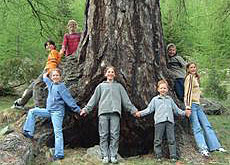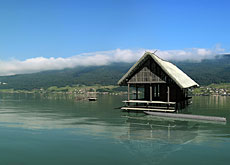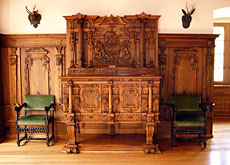Ancient trees stir modern passions

Experts are debating whether a larch in the Valais mountains, estimated at 1,500 years old, is indeed Switzerland's oldest tree.
If it proves to be as old as thought, the tree in the Goms Valley would have first cast down its roots at the end of Roman times. But whatever the outcome, public interest in the discovery shows that ancient trees continue to fascinate.
Drills, wood samples, and huge slices of tree trunks adorn the walls of Patrick Gassmann’s offices at the Latenium museum of archaeology in Neuchâtel, in western Switzerland.
Gassmann is an expert in dendrochronology – the science of dating trees through their ring patterns. He is well placed to consider the current conundrum over the Goms larch.
According to the expert, for the moment, the official oldest trees in the country are also larches, but situated elsewhere in Valais.
“The oldest trees are in the Hittuwald forest near the Simplon Pass – larches up to 1,000 years old,” Gassmann told swissinfo.
He said that more tests are needed before the Goms tree – the discovery of which was recently announced – can truly receive the oldest tree accolade.
Great age
Larches are the right candidates because they often survive to a great age, he said. Hardy trees, they live at high altitude, braving extremes of temperature.
“But they are rare because many of them were cut down in the high mountain pastures for cheesemaking,” said Gassmann.
If the Goms tree is indeed 1,500 years old then it will be as old as the larches that currently hold the European age record in the Ulten Valley in northern Italy.
But of course, this is still a lot younger than the world’s most ancient trees in the United States.
“In the White Mountains between California and Nevada you find pines that are more than 4,000 years old,” explained Gassmann.
“This gives you goosebumps, because imagine, these trees were born when Pharaoh Ramses II was on the throne. And they are still alive. They are most likely the oldest living things on earth.”
Fascination
This explains in part why ancient trees continue to exert such fascination. Apart from their magnificent appearance – these trees are often massive, gnarled and twisted – the fact that they seem to have witnessed so much history gives them a romantic air.
But sometimes people believe their local landmark is older than it really is, says Gassmann.
Dendrochronology allows the tree’s exact age to be pinpointed, but as the expert ruefully admits, not everyone likes the results.
He tells of one local village which was convinced it had a millennium oak, but was not best pleased to be told that it was “only” 400 years old.
Gassmann says there are no recorded examples of 1,000-year-old oaks in Switzerland. Four hundred years old is already rare.
Tree-ring analysis
To date a tree, Gassmann analyses the growth patterns of its rings – a ring is added each year.
The technique normally involves boring into the trunk to take a timber sample. “This doesn’t hurt the tree, it’s just like taking blood from humans,” says Gassmann.
He takes the wood back to his laboratory in Neuchâtel and examines it. Information is fed into a computer, which produces a pattern that looks rather like a heart monitor read-out.
This is then matched to a historical chart of patterns to find the exact date of the tree – a method also used to great success to date ancient sites in archaeology.
Part of Gassmann’s job involves travelling through the country to collect tree data. There are still many magnificent specimens, he says, but communities are often slow to realise that ancient trees need protection.
As there are no legal measures for this, it often falls to local authorities or individuals – the majority of Swiss forest is in private hands – to save threatened trees.
“Unfortunately there are still too many ancient trees being cut down,” said Gassmann.
swissinfo, Isobel Leybold-Johnson in Neuchâtel
Methuselah – currently the oldest known tree is a bristlecone pine (Pinus longaeva) in the White Mountains in the US. It is 4,789 years old. Its exact location is kept secret for its protection.
Prometheus – US scientist Donald R Curry was studying bristlecone pines in 1964. He obtained permission to fell one tree – Prometheus – for further study. It caused a scandal when it came to light that he had cut down the oldest living organism ever recorded at 4,884 years old.
Gassmann says that some people think African baobabs could be old, but this needs further study. Australia says its eucalyptus could be a contender. But the Swiss expert says that tropical trees are unlikely to be ancient because old trees usually grow in dry places at altitude.
The Neuchâtel laboratory was founded in 1975. Its main work is dating wood from Neolithic and Bronze Age lake dweller settlements (4,000-850 BC) in the area.
Scientists can also tell from the wood what kind of relation man had with the forest during these times. There is some evidence of very early forest management.
The laboratory has a reference bank of around 6,000 samples, with emphasis on oak, fir, spruce and larch.
Patrick Gassmann has worked at the laboratory for around 25 years. There are only around 300 dendrochronologists in Europe.

In compliance with the JTI standards
More: SWI swissinfo.ch certified by the Journalism Trust Initiative



You can find an overview of ongoing debates with our journalists here. Please join us!
If you want to start a conversation about a topic raised in this article or want to report factual errors, email us at english@swissinfo.ch.